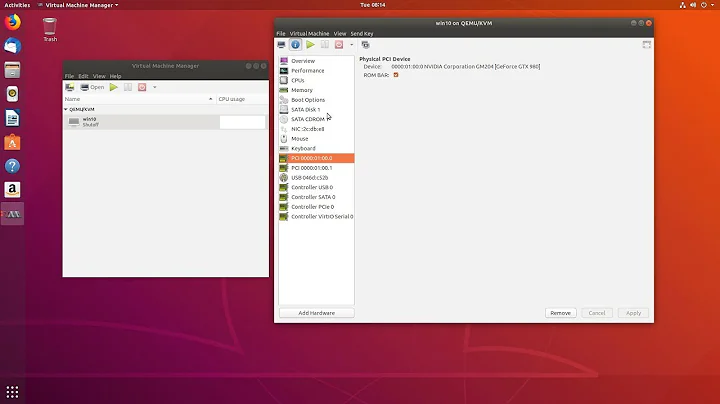How do I set up a KVM/NVidia Passthrough virtual machine for gaming?
Ok, I have been on this journey the last few days using Fedora 20, KVM, Xen (all from the Repo, no patches or self-builds) using a GTX260 (for the guest/windows 7) and a cheap GT610 for host/dom0:
- With KVM, some nvidia cards work but there are stability issues and your host can crash when rebooting the VM. I gave up on KVM because while it does work, it is far too unstable with my hardware.
- I got Xen to passthrough the GTX260, it was very stable and I could shutdown the domU with no weirdness. I installed the nvidia drivers but got a common issue of windows reporting the card wasn't working correctly so I only had basic VGA capability on the guest.
After some reading around, it turns out nvidia cards are pretty crippled when it comes to passthrough. AMD submitted patches to qemu/xen and AMD cards are reportedly working without too many issues on KVM. Quoting from the Xen wiki test cards:
All Radeon HD4xxx, HD6xxx and HD7xxx should work out-of-the-box as secondary adapter with Xen 4.2.1
This means your dom0 boots on one GPU and you passthrough a second GPU to your guest. There is also some support for handing off the primary GPU to a guest but this seems much less straightforward.
On the nvidia front, their high-end professional "Multi-OS" cards to work under Xen and KVM, but this is an artificial limitation placed on home/gamer cards by nvidia. Some people have been modding their cards to report as the equivalent quattro/grid card by replacing resistors on the board. This is possible because the multi-os cards are mostly identical to some higher-end home/gaming cards minus the device ID and some spec differences. Reading the boards, there are/were patches floating around that helped the nvidia case on Windows XP guests, but ... the whole nvidia thing just seems sketchy from a virtualization angle.
There's lots of this around (from the Xen wiki on GPU passthrough):
It's assumed you have a ATI Card you want to passthrough, simply because NVIDIA will only work a) with certain patches and b) with certain Windows Versions
In conclusion, based on what I know, if you want to do passthrough gaming ... go with Xen and AMD cards with a cheap or on-board GPU for dom0 and an additional GPU for the gaming domU. Performance is very high considering the virtualisation overhead too, between 95% and 97% of native framerates in benchmarks.
Good luck!
Some links that help:
- http://wiki.xen.org/wiki/XenVGAPassthroughTestedAdapters
- https://bbs.archlinux.org/viewtopic.php?id=162768
- http://wiki.xen.org/wiki/SecondaryGPUPassthrough
Related videos on Youtube
Byte Commander
Ask Ubuntu moderator♦, IT student and DevOps engineer. I love Ubuntu, Python, good music and coffee, although not necessarily in that order. You can easily contact me in the Ask Ubuntu General Room most of the time, or on Discord as @ByteCommander#2800. I'd also love to invite you to my Ubuntu Hideout Discord Server btw. PS: My profile picture is derived from "Wolf Tribals" by user HaskDitex (DeviantArt.com), which is under creative Commons 3.0 License. Currently I'm using the character "Dregg Morriss" from the game "Medieval Cop" by Vasant Jahav ("Gemini Gamer"). It can be found here.
Updated on September 18, 2022Comments
-
 Byte Commander almost 2 years
Byte Commander almost 2 yearsI've seen a guide or two that seems to be replicated around on the internet on setting up KVM to use passthrough for Nvidia. It seems to require 2 video cards.
Is it possible to do it with 1 video card? I'm trying to see if it's possible to have a gaming machine setup so I don't have to dual boot.
Is this possible? I've heard Xen has a passthrough of their own, but Nvidia doesn't seem to support it on their desktop cards.
I have a GTX 760.
Is it possible to virtualize and get native or near-native performance good enough for modern game gaming?
-
 Admin about 10 yearsPassing through a single video card needs it to be deactivated from the host. In case you have only 1 card your host would then be without video. This may not quite be what you hoped to get.
Admin about 10 yearsPassing through a single video card needs it to be deactivated from the host. In case you have only 1 card your host would then be without video. This may not quite be what you hoped to get.
-




